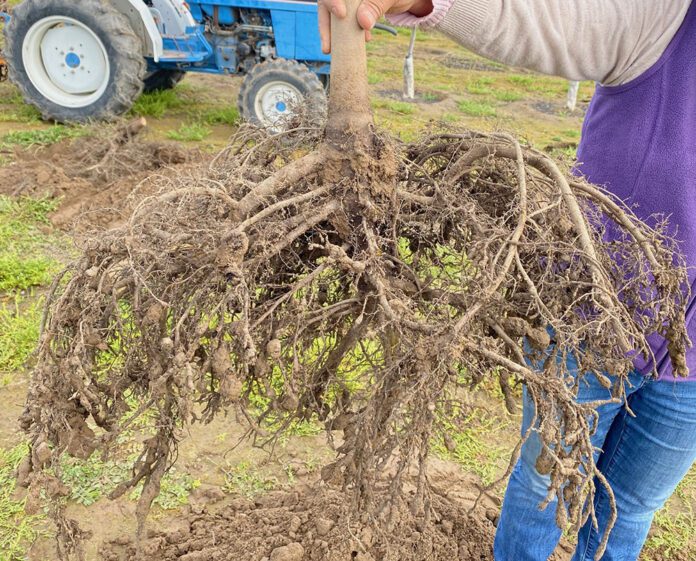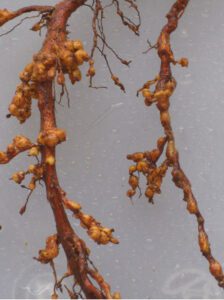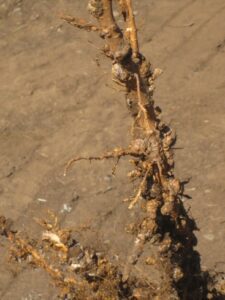
California produces over 400 different crops, many of them specialty and perennial crops that flourish on the state’s deep-rooting and fertile soils. These highly supportive growing conditions also favor infestations with parasites and pathogens that can host on the valuable crops. Among these, plant-parasitic nematodes rob yield as they feed below ground on roots of susceptible crops to sustain their own livelihoods. Many pathogens and pests are relatively easily recognized; insects can be viewed under minimal magnification, fungi cause characteristic symptoms, but plant-parasitic nematodes are conspicuous and do require laboratory examinations.
Many plant-parasitic nematodes are in a size dimension of 20 thousandths of an inch. This rather abstract size exemplifies that these microscopic roundworms live in a world far removed from the general human experience. Effects of their life activities become visible by generic reductions of plant growth, lack of vigor and reduced productivity. The amount of damage they cause is dependent on their numbers. While tiny, large numbers of them can cause severe damage by reducing root growth and function, and by consuming plant nutrients that would be otherwise converted into plant growth and yield.
The Lifecycle
Plant-parasitic nematodes occur in different genera and species. Their life histories can vary substantially. For example, root-knot nematodes are closely associated with the growth cycle of their host plants. Only infective stages of these nematodes are mobile in soil. Once in the roots, these nematodes trigger changes in the host tissue that allow them to establish feeding sites. As these specialized cells develop, the nematodes discontinue moving. The sedentary parasites go through their life cycle at this location within the root tissue. In response to the nematode feeding, the host plant produces bulgy tissue around the infection site that makes up the gall creating the name-giving root knots. Such deformations can be a first indication for the presence of nematodes of this group. Lab work should confirm the presence of the nematode females within these root galls. Plants with resistance hinder these nematodes from completing their life cycle, and population densities decline on them.

Root lesion nematodes live inside the root for a portion of their life cycle as well. At first infection, these nematodes may only feed from the outside on root tissues. Eventually, they penetrate the root and carry on with feeding. These nematodes continue moving within the plant root tissue and never become sedentary. They go through their life cycle while moving in the tissue and may return to the soil environment. These nematodes feed on cells they encounter while moving through the root tissues, removing contents from the impacted cells that may lose their function as a result. These nematodes do not cause the complex physiological changes as the sedentary nematodes would. Maybe because of this lack of intricate nematode host plant interaction it has been much more challenging to detect host plant resistance.
Multiple nematode species live in the soil surrounding the host plant roots and feed only from the outside on the root system. For example, ring nematodes show this type of behavior. They go through their entire life cycle while living in the soil. They feed from the outside of the root system on small roots and root hairs. This rather “casual” interaction with the plant challenges the development of host plant resistance. Nematodes can easily move from one root system to alternative roots that may be more conducive for their nourishment and development.
Soil Sampling
Orchard or vineyard establishment should include evaluation of potential nematode infestations. In annual crop production, crop rotation is a highly effective management strategy, but in perennials, this concept of changing crops can only be applied every few decades, and even then it is limited in its effectiveness. Yes, many soilborne pathogens and pests are host-specific, but plant-parasitic nematodes typically have fairly wide host ranges. For example, root lesion nematodes can damagingly infect almond, pistachio and walnut alike. While walnut is probably the most sensitive tree species, the other two tree nut crops can also be damaged. Knowing the nematode communities will guide rootstock choice and help in making soil treatment decisions.
The first step for nematode management is soil sampling. Planning goes a long way to obtain the most meaningful information in an efficient manner. When an orchard or vineyard is scheduled for renewal (or planting to an alternate perennial), it is most advisable to sample the still-in-place planting before removal.
The sampler can be guided to the most appropriate sample location that is perpendicular from the canopy edge to the soil surface in the irrigation zone of the tree or vine. Inherent challenges of uneven distribution of nematode populations in the soil matrix render soil sampling strategies crucial for obtaining meaningful data that support pest management decisions. The first concept is stratifying the field for obvious differences in cropping sequence or soil texture differences. At times of consolidating production units, often smaller fields with different field histories are combined to a large unit that provides efficiency of scale operations. Soil texture differences are frequently larger in the horizontal expanse of a field than easily meets the eye. Soil texture maps can help in identifying these strata.
A second limitation of soil sampling is the depth distribution of the parasitic species. Some stratification of populations of plant-parasitic nematodes can be observed (e.g., ring nematode is frequently found at elevated numbers in the upper 1.5 to 2 feet of depth.) In contrast, root lesion nematode can develop at depths wherever host plant roots are present. In research trials, soil samples from 5 feet deep still harbor large population densities of root lesion nematodes. This distribution becomes critical when designing soil sampling schemes.
Many circumstances can prevent soil sampling being done at the “perfect” time when the old orchard or vineyard is still in place, but the grower still needs to assess the nematode load of the field even if it is fallow. Once planting rows are obstructed by tillage operations, the likelihood of detecting nematode infestations is reduced. Any soil movement after plant removal dilutes infestation hot spots and makes detection of population densities more cumbersome. In addition, long, hot fallow periods coupled with topsoil tillage may dry out shallow soil layers. If this occurs quickly, nematode numbers may decline in these layers. At greater soil depths, the dry-down of the matrix is slowed, and nematodes may have a chance to adapt to the drier conditions, or simply survive in (minimally) hydrated root residues.
These processes result in low population densities in shallow soil layers despite the presence of nematodes at greater soil layers. This concept may result in erroneous results that nematode freedom is attested based on soil samples collected at 18 inches deep at the end of a summer fallow period. Populations present below this depth can reach newly planted perennials and lead to plant damage although the field was erroneously declared “clean.” To prevent these sampling mistakes in a late summer sampling, samples need to be taken from deeper soil layers. Soil of the collection layer should be at least earth-damp. Such a condition is likely to allow for nematode survival, and the likelihood of detecting residual populations is increased. Depending on the length of the fallow period, such layer may be 2 to 4 feet deep in soil. Also because of the dilution effects of tillage, more soil samples need to be collected for the composite sample to be sent to the lab. More information can be found at https://www.youtube.com/watch? v=U7x0xHoKqC8.

Understanding Results
Soil samples need to be kept cool in sealed plastic bags (to conserve moisture) while being transported to a nematology laboratory. Currently used extraction methods vary in extraction efficacy but have in common that they require the integrity of the nematode body, and some of them for the nematodes to be alive and active. Letting closed plastic bags be exposed to the sun or freezing the soil sample must be avoided as such will kill the nematodes and render extraction results erroneous. In the lab, known soil amounts are submitted to extraction procedures. The extraction method most used by commercial laboratories is a density centrifugation method that highly effectively extracts nematodes that are free in the soil matrix at the time of sample processing. Nematodes that are embedded in plant tissue at the time of processing are more effectively extracted using a sieve-mist extraction method in which samples are intermittently exposed to water mist for several days. Knowing what method was used is critical to interpret the results when the extracted nematodes are identified and counted. Based on the fairly crude extraction procedures, nematode numbers may be quite variable. As a result, thresholds when treatments are required are broad and preferentially given as comparatively wide ranges. Efforts are underway to improve these methods by molecular methods that focus on quantifying the nematode DNA following standardized extraction methods. The aim is to provide more accurate nematode quantification, and thus be able to make more accurate treatment recommendations.
Never assume nematodes are not a problem in a particular field. Rigor in information collection and proper action will be the route to success. Even at times of dwindling returns, the homework needs to be done when establishing new orchards and vineyards. The additional expense of proper soil sampling may appear unnecessary, but in most instances it will be well worth it when protecting the large investment into a new perennial planting.















